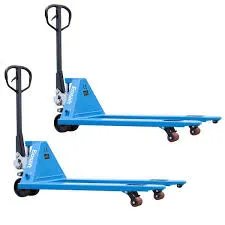


Understanding Standard Pallet Jacks A Vital Tool in Material Handling
In the world of logistics and warehousing, efficiency and productivity are paramount. One tool that has proven essential in these environments is the standard pallet jack, also known as a pallet truck. This piece of equipment plays a crucial role in moving heavy goods and optimizing warehouse operations, making it a staple in many businesses.
A standard pallet jack is designed to lift and transport pallets, which are flat structures used to support goods in a stable manner for handling and storage. Typically made from steel, pallet jacks come in various sizes to accommodate different pallet dimensions and weights. The most common type features forks that slide under the pallet and hydraulic mechanisms that enable lifting with minimal effort.
Design and Features
The design of a standard pallet jack is relatively straightforward yet highly effective. Most models include two forks, a hydraulic pump, and a handle for steering and lifting. The forks can be adjusted to fit under a standard pallet, allowing for easy engagement and disengagement. Once the forks are positioned correctly, the operator pulls the handle to engage the hydraulic system, lifting the pallet off the ground by a few inches. This functionality allows workers to move items without the need for additional manpower, significantly reducing the risk of injury.
Most standard pallet jacks are equipped with ergonomic handles that make it comfortable for workers to operate them over extended periods. Additionally, many models come with features such as load gauges, durable wheels for optimal maneuverability, and safety locks to ensure stability when loading and unloading.
Benefits of Using Pallet Jacks

The use of standard pallet jacks brings numerous benefits to businesses. One of the primary advantages is the reduction in labor costs. With pallet jacks, fewer people are needed to move heavy loads, allowing companies to allocate their workforce to other critical tasks. Furthermore, the risk of workplace injuries decreases, as manual lifting and straining are minimized. This can lead to lower insurance premiums and less downtime due to accidents.
Pallet jacks also enhance the overall efficiency of operations. With the ability to quickly transport goods across the warehouse, they help maintain a smooth flow of products from receiving to shipping. This efficiency is particularly important during peak seasons or when handling high volumes of stock that require rapid turnover.
Versatility and Applications
Standard pallet jacks are versatile tools used across various industries, including retail, manufacturing, and construction. They can handle a diverse range of materials, from packaged goods to heavy machinery parts. Their ability to navigate tightly spaced areas makes them ideal for warehouses where space is at a premium.
In retail settings, pallet jacks are often used for restocking shelves, aiding in the efficient movement of inventory from the backroom to the sales floor. In manufacturing, they facilitate the movement of raw materials to production areas, streamlining the manufacturing process.
Conclusion
In conclusion, standard pallet jacks are indispensable tools in modern material handling. Their robust design, combined with the numerous benefits they offer in terms of labor efficiency, safety, and operational productivity, makes them a preferred choice for businesses worldwide. As the logistics and supply chain industries continue to evolve, the pallet jack will remain a fundamental component, ensuring that products are moved swiftly and safely throughout warehouses and distribution centers. Whether in a small retail outlet or a large manufacturing facility, the standard pallet jack is indeed a vital asset in the pursuit of efficiency and effectiveness in material handling.



